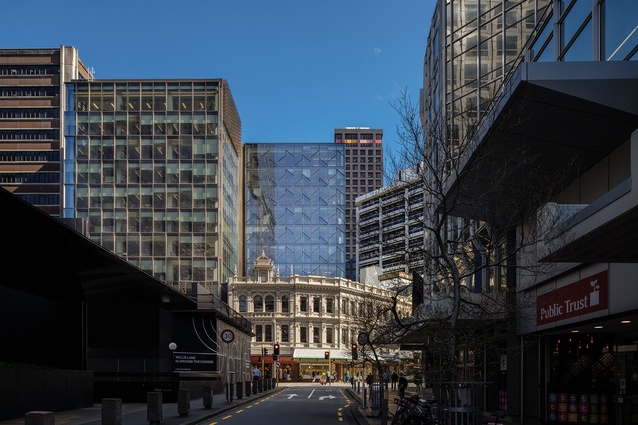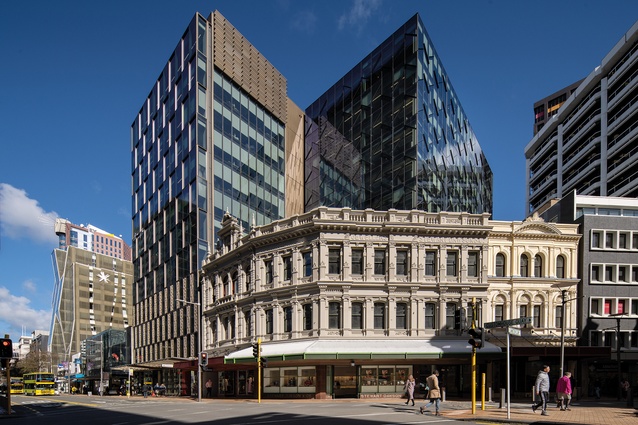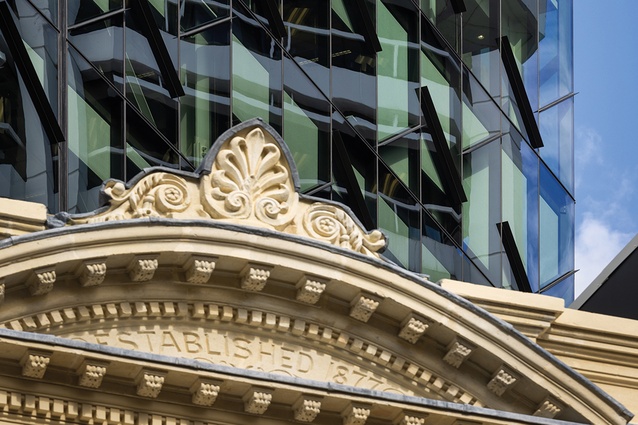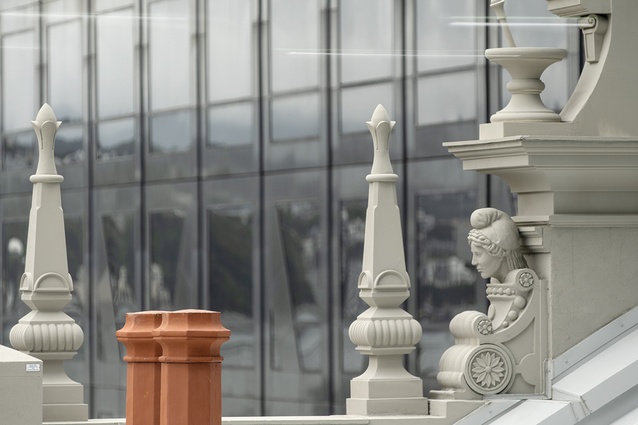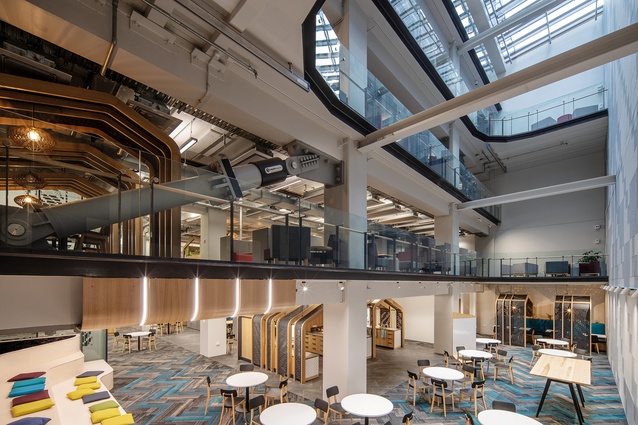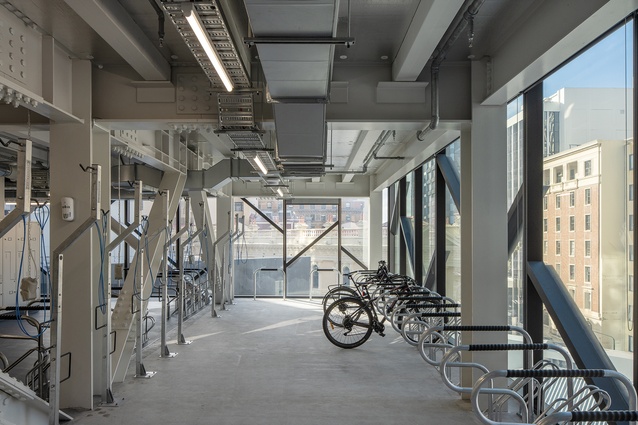Resonating to different frequencies
This project sits at the very heart of what was the original settlement of Wellington. It really was the maddest place to build a city. A beachfront site with a rocky headland at Kai-upoko, early settlers had to scramble up across the rocks at stormy high tides to get from Willis Street to Lambton Quay.
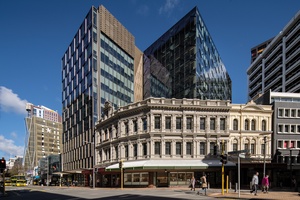
Plimmer’s Ark (an old ship used as a shop) sat across the street and bits of the hull sit there still in an old basement. There have been buildings here at Clay Point (aka Windy Point) ever since pākehā arrived. The clay of the point was made into bricks, building sites were created and early timber shacks on the site for grocers, butchers, milliners, fruit shops, mercery and haberdashers were replaced some years later by stone buildings for uses including as homes for City Meats and the Hungarian Club. For the last 120 years, it has been known as Stewart Dawson’s Corner after the resident jeweller (good news, they’re still going and they’re back). It has also been home to an awkward multi-storey building inserted in the intervening century and the corner is still highly contested: no longer by tides but, instead, by waves of buses and pedestrians passing by.
To say that this is a congested site would be an understatement; to say it was a complex project is way too simplistic. Five separate buildings: three elderly, one middle-aged, one new. It is six years since the start of the project, involving heritage restoration and rebuilding, moving the entire lift core to one side, and seismic separation between different structural systems, on Wellington’s busiest intersection. Meanwhile, the project continued to change scope amid the team’s negotiations with planners, developers, council, government departments and heritage advocates, on a project that can be serviced only via an awkward back passage from Boulcott Street via a nearby hillside, and all to be completed without inconveniencing anyone — phew! It is the sort of project that makes a true Wellingtonian proud. Argosy Property, McKee Fehl, Beca and Architecture +: my metaphorical hat goes off to you and all involved. Everyone should have a medal for sheer bloody-mindedness. Superb work, team.

So how did they get here? It started as a strengthening project for the EQ-prone heritage façades; the contractor hired the architect and the project grew from there. Town planning rules and changes regarding podiums and setbacks meant several options were put forward, discussed and, eventually, dismissed. Buildings became taller and better looking, with the outcome becoming crisp and refined. There are clearly three parts, with the original heritage buildings lying low on the corner and the two modern buildings visually playing off against each other, one recessed behind and the other prominently displayed to the side. All buildings have been earthquake strengthened, and the heritage façades restored to an almost fanatical degree, even retaining the original timber roofs (complete with trusses) and keeping them on display beneath a new, H1-compliant roof envelope.
Eight Willis Street, now home to Stats NZ, had the original awkward, ugly, pre-cast frontage removed and now has a new extended frontage, which reaches right to the street, floor plates enlarged, raised up, stripped out and refitted to exceed the current code. The lift core was deleted from the centre and now occupies the south side, leaving bigger, more open floor plates, with ceilings omitted to gain extra height in the offices. Viscous dampers have been installed to enable the seismic resilience of the concrete structure to reach 130 per cent of NBS. Services are neatly and carefully arrayed on display above, while the Jasmax fit-out has small refreshment pods dotted around the floors.

This building is also pierced with two multi-storey atria. The central, circular atrium appears highly successful: designed as the home of vertical circulation and spatial connection. It is not easy making a round hole in a square floor plate of existing pre-cast flooring and, so, an entire bay of concrete slab was cut out on each floor, and subsequently infilled with CLT to create a circular void. Timber and steel stairs were then craned into the hole and the whole atrium feels smooth and seamless, surrounded by fire curtains that will descend if ever needed.
The lower floors have integrated geometric filigree recessed into the glazing, visually tying into the height of the heritage frontages while, higher up, the glazing panels are intermittently recessed on the curtain wall: a subtle detail in the fenestration. Small, thin fins protrude outwards in places, providing just a touch more interest.
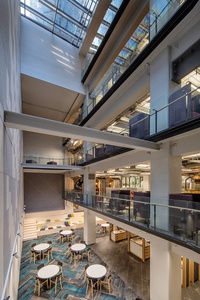
The newly created and, at times, interconnecting building at 366 Lambton Quay is tenanted to other governmental departments, including the Ministry for the Environment. Floor heights here are tied to the heritage frontages and do not always align with the building for Stats, so a seismic gap exists between the two to allow them to resonate to different frequencies. Sitting more on Lambton Quay, this building has a steel structure braced using K frames to give it the required stiffness, affecting the design ethos for the external cladding, where the APL unitised panels feature diagonal external angles reflecting that grunty angular structure within. The two buildings are clearly related but, also, clearly different, creating subtle patterns like tukutuku weaving across the façades.
The ironic result is that, after all that hard mahi, the tough toil fades into the background behind the fully restored and wonderfully detailed original façade of the three old buildings that are included in Stewart Dawson’s Corner. The left-hand building (architect Thomas Turnbull, 1872) was originally for Charles Fletcher, a chemist, replacing a timber structure built for a whaler in 1861. To the right side, ‘Berman’s Building’, a ‘simple but elegant Classical composition’ originally built for the Equitable Building and Investment Co. (architect Guido Schwartz, 1887), had Ōamaru stone for the bottom two floors and a brickwork extension above with the stone entablature reinstalled. The central building is the newest, built for Stewart Dawson and his jewellery shop (architect William Chatfield, 1903) in a more Edwardian classical style.
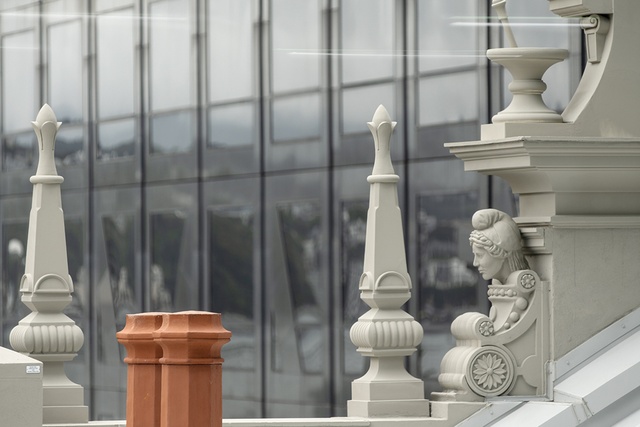
All three have been heavily strengthened and impeccably restored under the watchful heritage eye of Ian Bowman. Some original details on Fletcher’s Building had long since been rudely truncated and removed because of perceived earthquake risk and, so, had to be recreated from old photographs, carved in a 3D modelling package, and then sent off to Dunedin to be made anew in GRC. While it is the sort of detail only a sharp eye would notice, they look superb. Two carved heads, several finials, column capitals, an acroterion, chimney stacks and a couple of mortars and pestles for an apothecary now sit atop the façade, as happily now as they ever were, and almost as if they had never been absent at all.
Overall, the dynamics of the base buildings provide background for the carefully detailed Jasmax fit-out. Artwork by Māori artists Charles and Janine Williams reference waka landing on the nearby shores, and Ra Vincent’s dramatic carved pou ascends inside the spiral staircase in the atrium, while Te Aranga principles guide visitors throughout. These buildings have earned their place on the main street once again.


